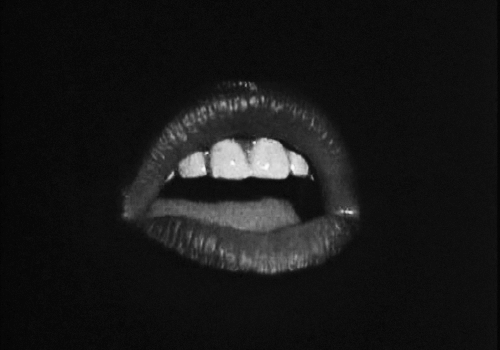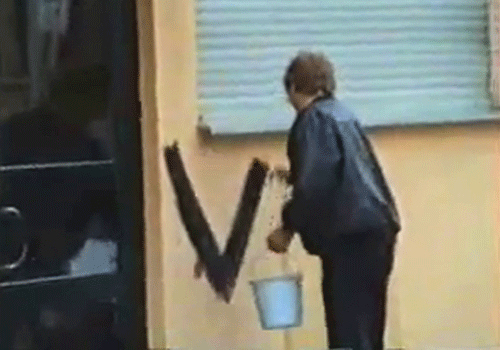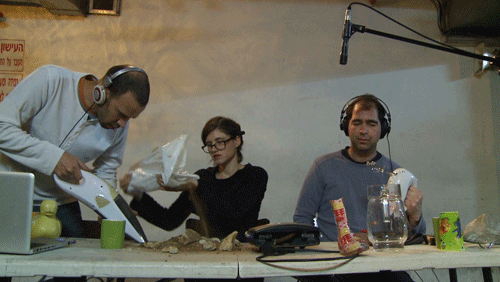Werkleitz Festival 2016: Trans-Positionen
Film program
Curated by Florian Wüst
13/14 October 2016
Zazie Kino & Bar, Kleine Ulrichstr. 22, 06108 Halle (Saale)
werkleitz.de

Though they are often seen as opposing phenomena, art and technology are inextricably connected. On one side humans, on the other side machines. We are all familiar with the subversive use of machines, devices and instruments as an artistic method or strategy. Yet without precise technological knowledge, pirate radio operators would not be able to build the broadcasting equipment to disseminate their politically and culturally subversive messages. The history of electronic music includes many close collaborations and a great deal of mutual inspiration between composers, engineers and scientists. In the age of the internet the age old question of the irreversibility of the conventional roles of the artist and technician, of the sender and recipient, of the producer and consumer is continually being re-examined. The four-part film program of the Trans-Positionen festival explores the reciprocal relationship between art and technology and counter and mainstream cultures, with a special emphasis on electronic and digital media. The international selection of historical and contemporary films extends the thematic focus beyond radio and television to include unusual forms of speech and the representation of societal crises and political upheaval. The film program also experiments with its own form: the combination of advertising, documentary, experimental film and music and the performance of a radio essay with film excerpts turns the cinema likewise into an absolute realm of acoustic experience.
13 October 2016, 19:00
Colorful Sounds

Das schönste Fenster der Welt, Herbert Viktor, 1968
"Every age has engendered its own characteristic music, shaped from the same forces that gave rise to the age itself. In our technological age music as an art form is subject to the forces of technology to an unprecedented degree." These words come from a circular letter of the Siemens company from the year 1963. The answer to this is the synthesis of music and technology: electronic music. In order to advance and further develop the automation of sound production, Siemens created its own studio, which was headed by the sound technician Alexander Schaaf and the composer Josef Anton Riedl and was in operation for three years. The Siemens studio for electronic music is indicative of the openness with which companies approached artistic experiments at the time, a tendency that is also to be seen in the production of elaborate corporate and image films. The film program, which includes Riedl’s Studien für elektronische Klänge (Studies for Electronic Sounds), surveys the communication technologies of the 20th century, from short-wave radio to color television to the mobile phone. Advertising and informational films made by the Philips, Siemens and AEG-Telefunken companies, Oskar Fischinger’s Radio Dynamics and a video by Bas van Koolwijk and Gert-Jan Prins, whose visual modulations originate from an audio mixer, will be juxtaposed with films by Mauricio Kagel, Christoph Doering and Michel Klöfkorn, who cast a critical and ironic look at the impending loss of reality in the face of omnipresent and infinitely reproducible images and data.
Europa Radio, Hans Richter, NL 1931, 9'
Radio Dynamics, Oskar Fischinger, US 1942, 4'
Farbige Klänge, Hans Fischerkoesen, BRD 1953, 2'
Studie für elektronische Klänge I, Josef Anton Riedl, 1959/62, 3'
Das schönste Fenster der Welt, Herbert Viktor, BRD 1968, 10'
Antithese, Mauricio Kagel, BRD 1965, 19'
Synchronator, Bas van Koolwijk, Gert-Jan Prins, NL 2006, 6'
Krause – oder ein beschriebener Film ist halt wie ein erzähltes Mittagessen, Christoph Doering, BRD 1988, 12'
Studie für elektronische Klänge IV, Josef Anton Riedl, 1959/62, 5'
geht's noch, Michel Klöfkorn, DE 2005, 5'
Followed by a talk with Christoph Doering.
13 October 2016, 21:00
World of Speech

Not I, Samuel Beckett, 1977
Unlike the five senses that provide us with impressions of the world, the voice lends us a form of expression, instilled with meaning through language. Yet the sounds produced—mumbled, spoken, sung, shouted —are as fleeting as they are direct. Sound vanishes in the air. Only with the invention of electronic media was it possible to record, store, alter, play back and broadcast human communication over great distances, turning the voice into an object of memory. Technical reproduction renders perfect what the voice appears to have been all along: an entity outside the body. The four films of World of Speech explore the relationship between sight and hearing and the forms of communication that defy rational interpretation and social norms—from the mysterious, vulnerable world of children in Gunvor Nelson’s My Name is Oona and Johan van der Keuken’s Blind Kind, to Not I by Samuel Beckett (who in his absurdist theatre and television works continually dramatized the senselessness of the world and the dubiousness of language), to Miriam Bajtala’s new film Sofern real about the depiction of mentally ill people by actors.
Not I, Samuel Beckett, UK 1977, 13'
Blind Kind, Johan van der Keuken, NL 1964, 25'
My Name is Oona, Gunvor Nelson, US 1969, 10'
Sofern real, Miriam Bajtala, AT 2015, 30'
Followed by a talk with Miriam Bajtala.
14 October 2016, 19:00
Von der Schönheit der Radiowellen

When Walter Klingenbeck was executed in 1943 in Munich-Stadelheim for high treason, the life of one of Germany’s first radio activists came to an abrupt end. Even after World War II illegal radio stations were part of the media culture of both East and West Germany. Among radio and pop culture historians there is now much enthusiasm for pirate stations that broadcast from international locations in order to avoid licensing fees and taxes. Their DJs provided the rising music industry with the necessary element of radical chic. What has been forgotten is that many political radio activists were technicians or engineers whose stations didn’t quite work. Or they had almost no listeners. What motivated them and where did the belief come from that they could change the world without a target group? Did with their great devotion, early radio activists define the conviction that now permeates the digital online world: that freedom can be achieved through technology? Originally produced for Bavaria Radio’s Nachtstudio in 2013, the radio essay Von der Schönheit der Radiowellen: Über Radioaktivisten und ihren Anspruch auf den Äther (The Beauty of Radio Waves) (writer/director: Ralf Homann, editor: Barbara Schäfer, sound technician: Siglinde Hermann) will be presented and performed for the first time in a cinema by Homann himself. The performance will include excerpts from the film comedy Piratensender Powerplay starring Mike Krüger and Thomas Gottschalk (1982) and Krsto Papic’s documentary Nek se cuje i nas glas (Let Our Voices be Heard Too) (1971).
Von der Schönheit der Radiowellen: Über Radioaktivisten und ihren Anspruch auf den Äther, Ralf Homann, 2013/16, 53'
Followed by a talk with Ralf Homann.
14 October 2016, 21:00
Time Travel

Soundtrack, Guy Ben-Ner, 2013
If a video camera is pointed at a monitor that simultaneously projects the camera image, an optical feedback results: the self-recording picture extends infinitely, similar to the escalating whine of a microphone held too close to a speaker. In Filipa César’s Transmission from the Liberated Zones this effect is less an aesthetic instrument than it is a visual representation of the attempt to superimpose history and the present, media images and subjective narratives, which in the face of new wars and refugee crises all revolve around the same thing: the struggle for a life in freedom. In the films of Guy Ben-Ner, Erik Bünger and Clemens von Wedemeyer, feedback, re-enactment and reproduction are also at the root of an artistic exploration of social conflicts and cultural practices that reflect the conditions of production in the film industry. With a focus on sound and language, monologue and translation in film, the fourth and final film program also sheds light on the festival’s main theme: radio.
Soundtrack, Guy Ben-Ner, IL 2013, 11'
The Allens, Erik Bünger, SE 2004, 2'
The Cast (Procession), Clemens von Wedemeyer, IT 2013, 15'
Transmission from the Liberated Zones, Filipa César, DE/SE/PT/FR 2015, 30'
Followed by a talk with Filipa César.